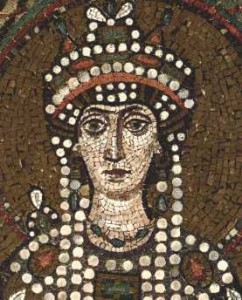Theodora (c.500 – 28 June 548) was Empress of the Byzantium Empire from 527 to 548 through her marriage to the Emperor Justinian.
‚ÄèTheodora has an interesting personal history which lead her to this moment, as she was an unlikely wife for the future Emperor of Byzantium.
‏Sources dispute where she was born, with possibilities being Syria, Cyrpus and Paphlagonia, however she lived for part of her youth in Constantinople (present day Istanbul). Her father was a bear trainer for the Hippodrome and her mother was a dancer and actress. Theodora’s father died when she was very young, and the lack of support the family received from the green faction, resulted in the family requesting to the join the blue faction. Theodora remained a part of the blue faction for the rest of her life. The blues and greens were the two rival political factions in the Byzantium Empire.
‏Theodora’s early life included work as a dancer and an actress liker her elder sister. This kind of work would also have included work of a sexual nature off stage. Theodora achieved notoriety for her suggestive portrayal of Leda and the Swan. At the age of 16, Theodora caught the attention of a government official named Hecebolus who she then moved to the North Africa with. She lived there for four years with him until he abandoned her. On her way back to Constantinople she met Patriarch Timonthy III and she converted to Miaphysite Christianity.
‚ÄèOn her return to Constantinople Theodora did not return to her former profession, but instead became a wool spinner. Her charisma, intelligence and beauty caught the eye of Justinian, but because she was a former actress and he was a government official they could not legally marry. Not only was Justinian a government official he was also the heir to his uncle Emperor Justin I, and while his uncle liked Theodora, his wife Euphemia was against the match. When Euphemia died in 525, Justin I repealed the law that prevented Theodora and Justinian marrying. Two years later Justin died and Justinian and Theodora became Emperor and Empress of Byzantine.
‚ÄèOne of the biggest challenges of their reign was the Nika riots of 532. It began between the greens and the blues at a chariot race during the Hippodrome and spread throughout the city, much of which was set on fire. This was a direct threat to their reign. Theodora convinced Justinian and his officials not to flee Constantinople, but to stay and deal with the rioters. This decisive judgement is what saved his throne. After the destruction of the city, Theodora and Justinian began to rebuild the city and this work is what gave Constantinople the incredible architecture that is was known for centuries, the pinnacle of this being the Hagia Sophia church.
‚ÄèShe was also very progressive in the laws she passed which helped women, including: making forced prostitution illegal, closing down brothels, creating a convent for ex-prostitutes and implementing a death penalty for rape.
‚ÄèTheodora came from humble beginnings to Empress of Byzantine. She was an incredibly intelligent woman and was completely respected by her husband, allowing her to use her skills for the benefit of the empire.
‚ÄèIf you‚Äôd like to read more about the fascinating Theodora, try Stella Duffy’s two books about her, Theodora: Actress, Empress, Whore and The Purple Shroud.
-Danielle Triggs
Junior Girl
Girl Museum Inc.

